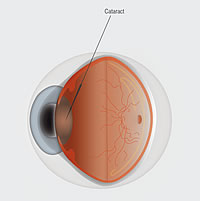Many patients become overwhelmed when they hear that they have cataracts and get concerned about the surgery that will follow. This is completely normal; in fact it is a myth that cataract surgery is painful. Cataract surgery is one of the most commonly performed surgical procedures performed in the United States today.
Cataract Surgery - phacoemulsification
No Stitch, No Needle Cataract Surgery
 The modern day cataract surgery technique is routinely performed with small incision micro-surgery through a process known as phacoemulsification. The cataract removal and surgical process is actually done using the smallest possible incision, and removal of the lens material is accomplished using an ultrasonic probe. Before a new intraocular lens can be implanted, the hardened cataract needs to be removed. First your eye must be properly cleaned and dilated. A topical anesthetic is applied. Next a micro-incision about the size of 3 millimeters is created at the junction of the cornea and the white part of the eye known as the sclera. An ultrasonic device will be inserted into the small incision to pulverize the hard yellow proteins that form the cataract, and remove them from the eye.
The modern day cataract surgery technique is routinely performed with small incision micro-surgery through a process known as phacoemulsification. The cataract removal and surgical process is actually done using the smallest possible incision, and removal of the lens material is accomplished using an ultrasonic probe. Before a new intraocular lens can be implanted, the hardened cataract needs to be removed. First your eye must be properly cleaned and dilated. A topical anesthetic is applied. Next a micro-incision about the size of 3 millimeters is created at the junction of the cornea and the white part of the eye known as the sclera. An ultrasonic device will be inserted into the small incision to pulverize the hard yellow proteins that form the cataract, and remove them from the eye.
After the cataract is removed, Dr. Schnipper is ready to implant an intraocular lens. This is a crucial point of understanding for patients. Patients can either have a monofocal lens which will only correct vision for one distance or they can opt to upgrade to premium lens implant that can reduce or eliminate their need for glasses after cataract surgery. There is an additional cost to upgrade to premium IOLs, while traditional monofocal lenses are covered by Medicare.
Click here to learn more about your premium lens options

A folded intraocular lens will be inserted through the original incision. This lens will replace your natural lens and stay in place inside your eye, providing you with clear vision after the procedure. You will not be able to feel or sense the implanted lens in any way. The small incision will then self-seal itself without the need for stitches.
What Happens after Cataract Surgery?
Recovery from cataract surgery is generally very quick. Most patients can see more clearly within the first 24 hours of the procedure. Itching and mild discomfort are normal after cataract surgery. Some fluid discharge is also common. Your eye may be sensitive to light and touch. If you have discomfort, Robert I. Schnipper, MD will suggest treatment. After one or two days, any moderate discomfort should disappear.
You will be given a prescription for eye drops to help healing and decrease the risk of infection. Dr. Schnipper and his team will instruct you how to use these eye drops, how often to use them, and what effects they can have. You will need to wear an eye shield or eyeglasses to help protect your eye. Avoid rubbing or pressing on your eye.
In most cases, healing will be complete within eight weeks. Jacksonville Eye Center will schedule exams to check on your progress. Each person heals differently so it is important to discuss the cataract surgery recovery with your eye doctor.